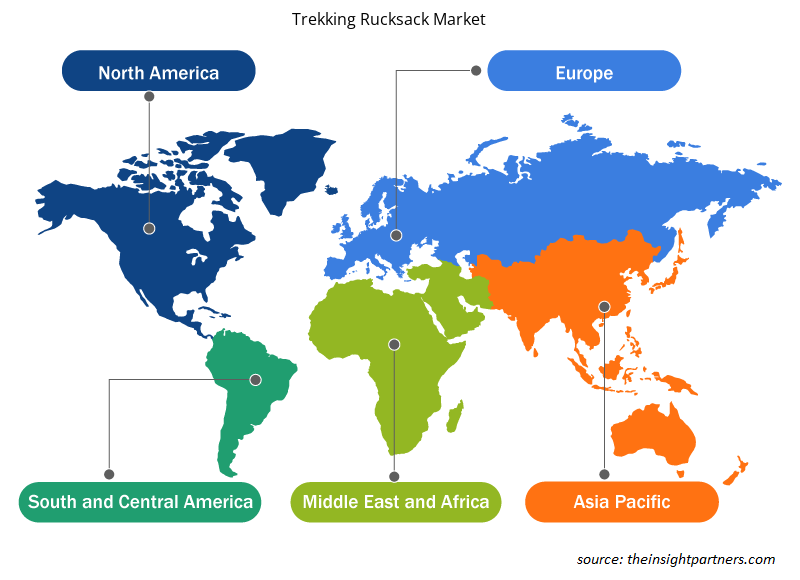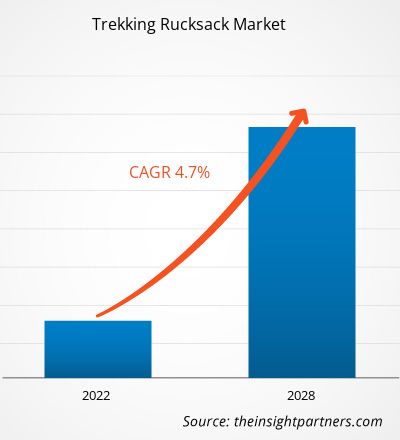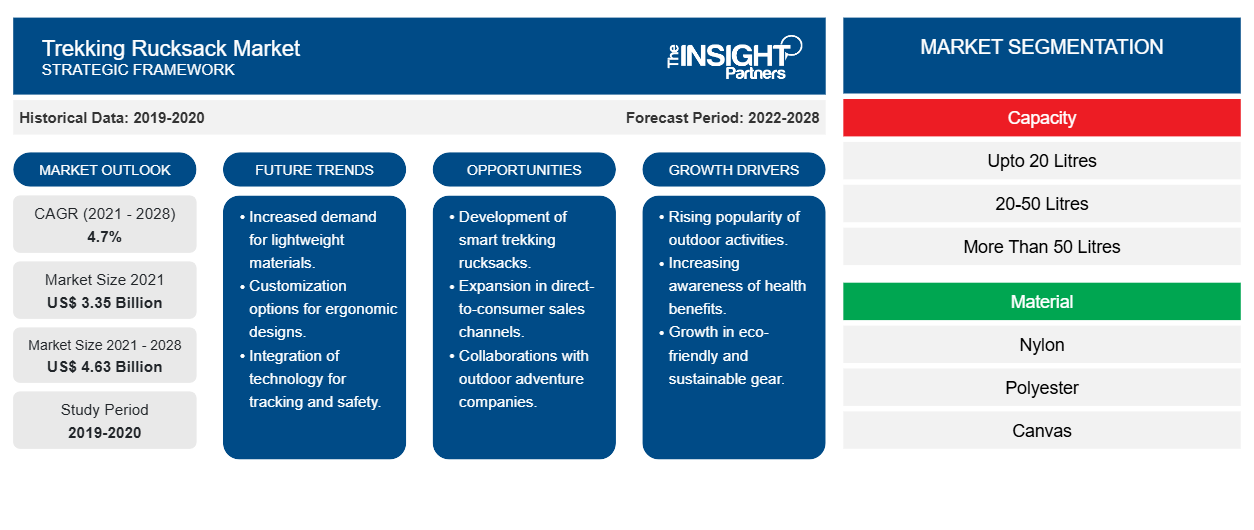Il mercato degli zaini da trekking è stato valutato 3.349,66 milioni di dollari nel 2021 e si prevede che raggiungerà i 4.627,68 milioni di dollari entro il 2028; si prevede una crescita a un CAGR del 4,7% dal 2021 al 2028.CAGR of 4.7% from 2021 to 2028.
Lo zaino da trekking è un tipo di zaino con tasche aggiuntive e cinture sui fianchi o sul petto per trasportare un carico più pesante durante il trekking. I produttori di questi sacchi si concentrano sulla qualità, sul materiale e sul peso del prodotto per soddisfare le preferenze dei consumatori in continua evoluzione, influenzate dal comfort e dalle condizioni ambientali. Ad esempio, Amer Sports, tramite il suo marchio Arc'teryx, fornisce zaini impermeabili realizzati con sostanze chimiche perfluorurate (PFC). Gli operatori del mercato si stanno anche concentrando sull'offerta di zaini da trekking personalizzati per le donne, poiché il numero di trekker donne è in continuo aumento in tutto il mondo.
Nel 2020, il Nord America deteneva la quota maggiore del mercato degli zaini da trekking . Tuttavia, si stima che l'Asia-Pacifico registrerà il CAGR più elevato nel mercato durante il periodo di previsione. In Nord America, le Montagne Rocciose del Colorado e il Pacific Crest Trail verso l'Appalachian Trail sono alcune delle famose destinazioni di trekking, che attraggono persone dalla regione e da altre parti del mondo. Pertanto, il continuo afflusso di un gran numero di trekker sta aumentando il consumo di zaini da trekking. Secondo un rapporto pubblicato da un'associazione del settore outdoor, il 34% dei consumatori di prodotti per la ricreazione all'aperto è composto da persone attive, etnicamente diverse e giovani, residenti in città. Inoltre, anche gli anziani si stanno dedicando ad attività all'aperto per tenere sotto controllo la propria salute, il che sta aumentando la popolarità dei trekking più brevi in Nord America.
Personalizza questo report in base alle tue esigenze
Riceverai la personalizzazione gratuita di qualsiasi report, comprese parti di questo report, o analisi a livello nazionale, pacchetto dati Excel, oltre a usufruire di grandi offerte e sconti per start-up e università
-
Scopri le principali tendenze di mercato in questo rapporto.Questo campione GRATUITO includerà analisi di dati che spaziano dalle tendenze di mercato alle stime e alle previsioni.
Impatto della pandemia di COVID-19 sul mercato degli zaini da trekking
Inizialmente, la pandemia di COVID-19 ha avuto un impatto negativo sul mercato degli zaini da trekking. Lo scoppio ha distorto l'efficienza operativa e interrotto le catene del valore a causa della chiusura dei confini nazionali e internazionali, creando perdite di fatturato e danni. Il blocco nazionale ha spinto le persone a rimanere a casa. Inoltre, l'interruzione della produzione ha avuto un impatto negativo sul mercato degli zaini da trekking nella prima metà del 2020. La chiusura di negozi al dettaglio, minimarket, supermercati e ipermercati, tra gli altri canali di distribuzione dei fornitori di zaini da trekking, ha ostacolato le loro vendite. Tuttavia, con un numero crescente di persone vaccinate, si è assistito a un allentamento delle restrizioni del blocco. I viaggi internazionali e nazionali sono ripresi con una crescente preferenza per le attività ricreative e il turismo d'avventura tra la popolazione mondiale. Il numero di escursionisti ha assistito a un'impennata drammatica nel 2021 rispetto all'anno precedente 2020. Le persone stanno optando per il trekking come fuga nel fine settimana per mantenere un equilibrio di salute fisica e mentale. Pertanto, la domanda di zaini da trekking è in aumento a livello globale.
Approfondimenti di mercato
Le caratteristiche vantaggiose del prodotto aumentano la crescita del mercato degli zaini da trekking
Lo zaino da trekking è uno zaino con tasche aggiuntive e cinture sui fianchi o sul petto per trasportare un carico più pesante durante il trekking. I trekker usano questi zaini durante un'escursione giornaliera o un breve trekking notturno per trasportare indumenti, attrezzature e accessori essenziali, nonché cibo e acqua. Uno zaino ideale è leggero; impermeabile; espandibile; offre una buona ventilazione posteriore; e ha una buona organizzazione delle tasche, cerniere resistenti e cinture regolabili. Tali caratteristiche vantaggiose li rendono una scelta desiderata tra i trekker.
Uno zaino con una capacità di oltre 50 litri è adatto sia per le escursioni del fine settimana che per le avventure di una settimana con lo zaino in spalla. Le cinture e gli spallacci regolabili incorporati consentono di regolare la posizione dello zaino in base alla lunghezza del busto e alla circonferenza della vita del trekker, garantendo così un'esperienza di trekking fluida e confortevole. Inoltre, gli spallacci/cinture sono imbottiti con una struttura a nido d'ape per facilitare una distribuzione uniforme della pressione. La caratteristica regolabile delle cinture e degli spallacci aderenti al corpo aiuta anche a mantenere un equilibrio corretto durante il trekking.
Informazioni sulla capacità
In base alla capacità, il mercato globale degli zaini da trekking è suddiviso in fino a 20 litri, 20-50 litri e oltre 50 litri. Questi zaini sono progettati per un uso di più giorni e sono utilizzati per trasportare carichi più pesanti rispetto agli zaini giornalieri. La maggior parte di questi zaini avrà tutte le caratteristiche presenti in uno zaino giornaliero, ma con punti di fissaggio aggiuntivi, imbottiture e tasche. Gli zaini hanno anche spazio per trasportare qualsiasi attrezzatura o equipaggiamento extra di cui un viaggiatore potrebbe aver bisogno durante il trekking. Lo zaino è ideale per coloro che vanno in viaggio per una notte. Lo zaino da 50 litri è sufficiente per contenere sacco a pelo, tenda e vestiti per un'escursione di 3 giorni. Il segmento è uno dei più popolari poiché numerosi viaggiatori vanno in trekking nel fine settimana e avrebbe un pubblico target di consumatori che sono viaggiatori leggeri o moderati. Si prevede che il segmento vedrà elevate prospettive di crescita poiché un numero maggiore di persone sta prendendo parte ad attività ricreative all'aperto e i trekking di due giorni sono tra i più popolari tra i viaggiatori.
Approfondimenti sui materiali
In base al materiale, il mercato globale degli zaini da trekking è suddiviso in nylon, poliestere, tela e altri. Il segmento in nylon rappresenta la quota di mercato maggiore. Si prevede che il segmento in poliestere registrerà il CAGR più elevato nel mercato teg durante il periodo di previsione. Il nylon, noto anche come termoplastico, è un polimero artificiale che deriva tipicamente dal petrolio. È durevole, leggero e liscio. Inoltre, può essere modificato in qualsiasi design o forma aggiungendo un agente di delustering quando è nella fase fusa, rendendolo una fibra flessibile. Il materiale ha una maggiore elasticità, che consente di sistemare comodamente grandi quantità di bagagli in questi zaini. Inoltre, grazie all'eccellente flessibilità del prodotto, il materiale può tornare comodamente al suo stato originale senza pieghe e rughe. In genere, quando il materiale viene allungato per troppo tempo, le fibre diventano morbide e sottili ma mantengono la loro resistenza. Il nylon ha anche un basso tasso di assorbenza, che fornisce agli zaini resistenza all'acqua e li rende ideali per l'uso nelle aree tropicali. Gli zaini in nylon sono facili da pulire; poiché il tessuto è liscio, lo sporco non si attacca alla sua superficie. Inoltre, gli zaini in nylon sono resistenti al 100% a funghi, muffe o funghi, nonché ad ambienti alcalini.
Informazioni sui canali di distribuzione
In base al canale di distribuzione, il mercato globale degli zaini da trekking è suddiviso in supermercati e ipermercati, negozi specializzati, vendita al dettaglio online e altri. Il segmento dei negozi specializzati ha rappresentato la quota di mercato maggiore nel 2020 e si prevede che il segmento della vendita al dettaglio online registrerà il CAGR più elevato nel mercato durante il periodo di previsione. I negozi specializzati sono tra i canali di distribuzione più importanti per gli operatori del mercato degli zaini da trekking in quanto offrono categorie di prodotti specifiche con una varietà più ampia rispetto a supermercati e ipermercati. Alcuni dei negozi specializzati più popolari includono Sport Scheck, Sport 2000 e Intersport. Grazie alla forte fedeltà al marchio per alcuni marchi di zaini da trekking, le persone preferiscono acquistare questi prodotti nei negozi specializzati. I negozi specializzati utilizzano campagne promozionali per attrarre clienti e mantenere un afflusso costante di visitatori. Questi negozi sono solitamente collocati in importanti punti vendita al dettaglio, tra cui complessi commerciali e centri commerciali, e utilizzano tecniche di merchandising per fornire un'esperienza di acquisto complessivamente ricca per i consumatori. Questi negozi offrono anche numerosi altri prodotti ricreativi all'aperto, come l'attrezzatura per l'alpinismo, che migliora ulteriormente l'esposizione del prodotto al pubblico di destinazione. Molti negozi stanno adottando strumenti digitali avanzati per migliorare l'esperienza di acquisto dei consumatori. Ad esempio, Timberland ha iniziato di recente a incorporare i chip RFID in tutti i prodotti nella sua sede di New York. Quando si posizionano i prodotti vicino ai tablet, le informazioni sui prodotti vengono visualizzate sui tablet. Vengono visualizzati anche articoli consigliati e correlati e il cliente può scegliere gli articoli da aggiungere alla propria collezione personale.
Alcuni attori che operano nel mercato degli zaini da trekking sono Arc'teryx; Deuter Sport GmbH; Equip Outdoor Technologies UK LTD; Granite Gear LLC; Mufubu; Tripole Gears; Vango; Wildcraft; Osprey Packs, Inc; e Hyperlite Mountain Gear Inc. Queste aziende presentano un ampio portafoglio di prodotti sul mercato. Le aziende sono presenti nelle regioni in via di sviluppo, offrendo così opportunità redditizie per la crescita del mercato degli zaini da trekking in queste regioni. Gli attori del mercato stanno sviluppando prodotti di alta qualità e innovativi per soddisfare le esigenze del cliente.
Segnala i riflettori
- Tendenze progressive del settore nel mercato degli zaini da trekking per aiutare i player a sviluppare strategie efficaci a lungo termine
- Strategie di crescita aziendale adottate dai player per soddisfare i mercati sviluppati e in via di sviluppo
- Analisi quantitativa del mercato degli zaini da trekking dal 2019 al 2028
- Stima della domanda globale di zaini da trekking
- Analisi PEST per illustrare l'efficacia degli acquirenti e dei fornitori che operano nel settore
- Sviluppi recenti per comprendere lo scenario competitivo del mercato
- Tendenze e prospettive del mercato, nonché fattori che guidano e frenano la crescita del mercato degli zaini da trekking
- Assistenza nel processo decisionale evidenziando le strategie di mercato che sostengono l'interesse commerciale, portando alla crescita del mercato
- Le dimensioni del mercato degli zaini da trekking in vari nodi
- Panoramica dettagliata e segmentazione del mercato, nonché dinamiche del settore degli zaini da trekking
- Dimensioni del mercato degli zaini da trekking in varie regioni con promettenti opportunità di crescita
Approfondimenti regionali sul mercato degli zaini da trekking
Le tendenze regionali e i fattori che influenzano il mercato degli zaini da trekking durante il periodo di previsione sono stati ampiamente spiegati dagli analisti di Insight Partners. Questa sezione discute anche i segmenti e la geografia del mercato degli zaini da trekking in Nord America, Europa, Asia Pacifico, Medio Oriente e Africa e America centrale e meridionale.

- Ottieni i dati specifici regionali per il mercato degli zaini da trekking
Ambito del rapporto di mercato sugli zaini da trekking
| Attributo del report | Dettagli |
|---|---|
| Dimensioni del mercato nel 2021 | 3,35 miliardi di dollari USA |
| Dimensioni del mercato entro il 2028 | 4,63 miliardi di dollari USA |
| CAGR globale (2021 - 2028) | 4,7% |
| Dati storici | 2019-2020 |
| Periodo di previsione | 2022-2028 |
| Segmenti coperti |
Per capacità
|
| Regioni e Paesi coperti |
America del Nord
|
| Leader di mercato e profili aziendali chiave |
|
Densità degli attori del mercato: comprendere il suo impatto sulle dinamiche aziendali
Il mercato degli zaini da trekking sta crescendo rapidamente, spinto dalla crescente domanda degli utenti finali dovuta a fattori quali l'evoluzione delle preferenze dei consumatori, i progressi tecnologici e una maggiore consapevolezza dei vantaggi del prodotto. Con l'aumento della domanda, le aziende stanno ampliando la propria offerta, innovando per soddisfare le esigenze dei consumatori e capitalizzando sulle tendenze emergenti, il che alimenta ulteriormente la crescita del mercato.
La densità degli operatori di mercato si riferisce alla distribuzione di aziende o società che operano in un particolare mercato o settore. Indica quanti concorrenti (operatori di mercato) sono presenti in un dato spazio di mercato in relazione alle sue dimensioni o al valore di mercato totale.
Le principali aziende che operano nel mercato degli zaini da trekking sono:
- Arcteryx
- Deuter Sport GmbH
- Equipaggia tecnologie esterne UK Ltd
- Granito Gear LLC
- Mufubu
Disclaimer : le aziende elencate sopra non sono classificate secondo un ordine particolare.

- Ottieni una panoramica dei principali attori del mercato degli zaini da trekking
Mercato degli zaini da trekking – per capacità
- Fino a 20 litri
- 20–50 litri
- Più di 50 litri
Mercato degli zaini da trekking – per materiale
- Nylon
- Poliestere
- Tela
- Altri
Mercato degli zaini da trekking – per canale di distribuzione
- Supermercati e Ipermercati
- Negozi specializzati
- Vendita al dettaglio online
- Altri
Profili aziendali
- Arcteryx
- Deuter Sport GmbH
- Equipaggia tecnologie esterne UK Ltd
- Granito Gear LLC
- Mufubu
- Ingranaggi tripolari
- Vango
- Artigianato selvaggio
- Pacchi Osprey, Inc.
- Attrezzatura da montagna Hyperlite Inc.
- Analisi storica (2 anni), anno base, previsione (7 anni) con CAGR
- Analisi PEST e SWOT
- Valore/volume delle dimensioni del mercato - Globale, Regionale, Nazionale
- Industria e panorama competitivo
- Set di dati Excel
Report recenti
Testimonianze
Motivo dell'acquisto
- Processo decisionale informato
- Comprensione delle dinamiche di mercato
- Analisi competitiva
- Analisi dei clienti
- Previsioni di mercato
- Mitigazione del rischio
- Pianificazione strategica
- Giustificazione degli investimenti
- Identificazione dei mercati emergenti
- Miglioramento delle strategie di marketing
- Aumento dell'efficienza operativa
- Allineamento alle tendenze normative























 Ottieni un campione gratuito per - Mercato degli zaini da trekking
Ottieni un campione gratuito per - Mercato degli zaini da trekking